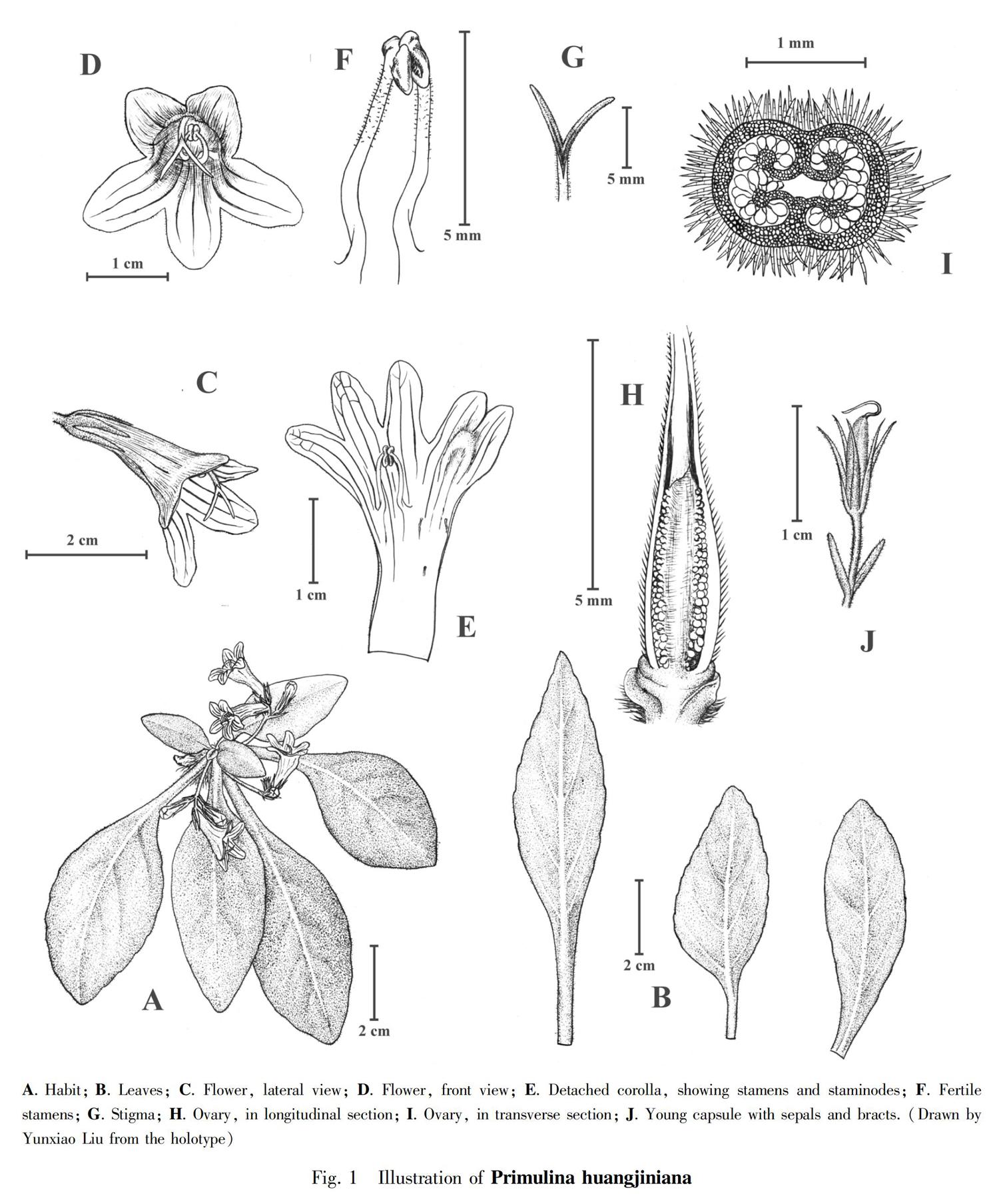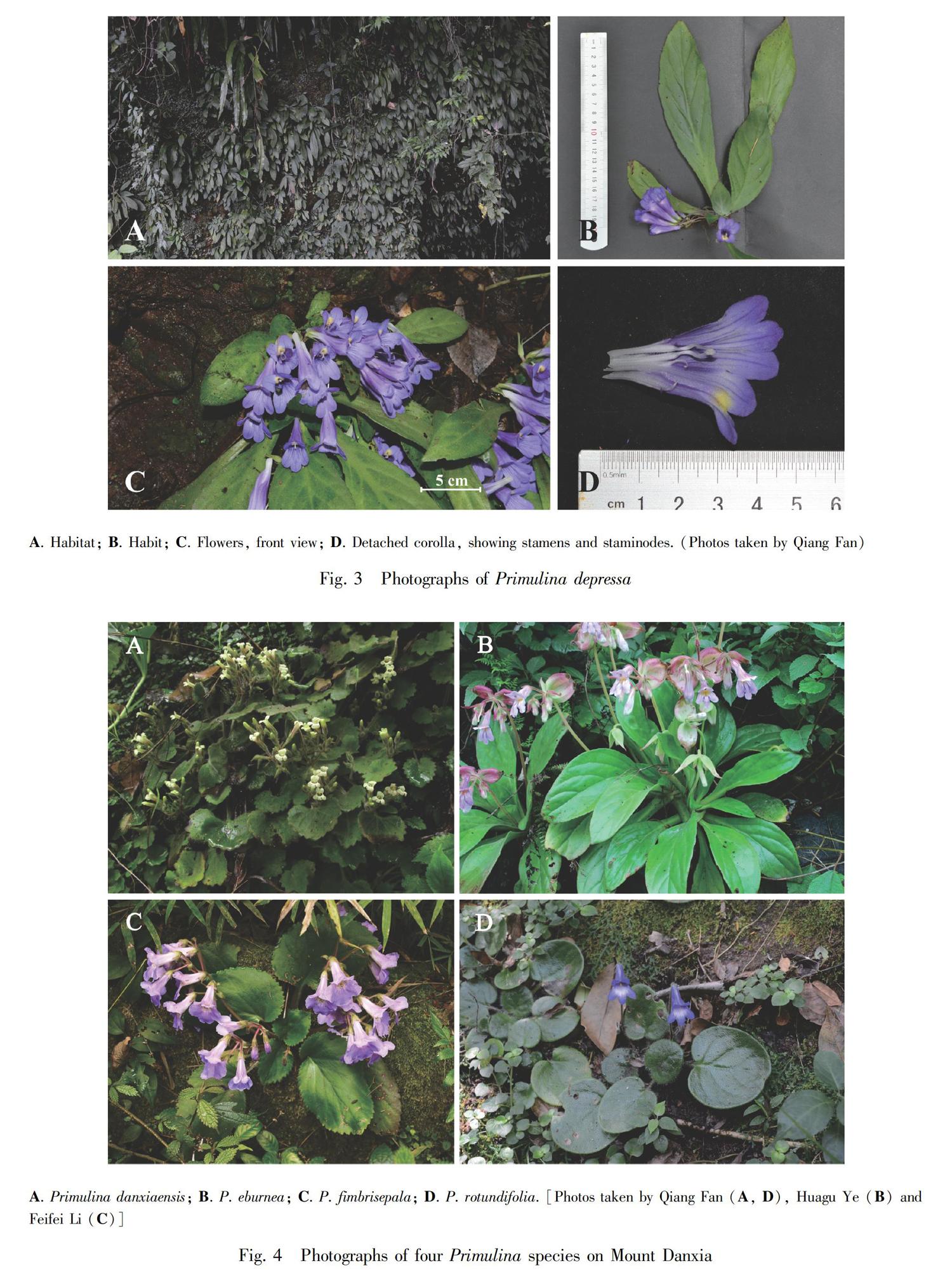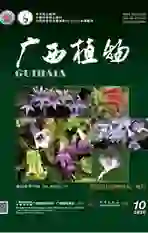广东报春苣苔属一新种
2020-12-14黄翠莹孟开开郭剑强陈昉廖文波凡强
黄翠莹 孟开开 郭剑强 陈昉 廖文波 凡强



摘 要: 該文报道了在广东丹霞山发现的报春苣苔属一新种——黄进报春苣苔(Primulina huangjiniana),并对其进行了描述。该新种与同属物种短序报春苣苔(P. depressa)最为相似,但两者在形态特征上能够很好地区别:黄进报春苣苔具有更短的、长2.5~6 mm的苞片(vs. 短序报春苣苔具有长15~30 mm的苞片,顺序下同);花萼裂片等长(vs. 不等长),花丝基部附近膝状突起,中部以上具腺毛(vs. 于中部膝状突起且无毛);柱头倒三角形,深2裂成2线形裂片(vs. 片状,稍2浅裂,裂片为三角形),侧膜胎座(vs. 中轴胎座)。加上该新种在内,丹霞山目前共记录有6种报春苣苔属植物,其中丹霞小花苣苔(P. danxiaensis)和该新种均为丹霞地貌特有植物。黄进报春苣苔目前在丹霞山的两个地方有发现,成年植株不超过200株,根据IUCN红色名录标准,属于极危种。
关键词: 丹霞, 长蒴苣苔亚科, 广东植物区系, 形态学比较, 短序报春苣苔
1 Introduction
The redefined Primulina Hance, based on the re-circumscription of recent molecular phylogenetic studies, is the largest genus in the subfamily Didymocarpoideae of Gesneriaceae with about 204+ species (including subspecies and varieties) in China (Wen et al., 2019, 2020), including nearly all previous species of Chirita sect. Gibbosaccus Clarke, all species of Chiritopsis W. T. Wang, and two species of Wentsaiboea D. Fang & D. H. Qin (Wang et al., 1998; Fang & Qin, 2004; MOller et al., 2011; Wang et al., 2011; Weber et al., 2011; Xu et al., 2012; Wang et al., 2017). Its species diversity is still growing rapidly due to numerous new species being constantly discovered and described since the past decade (Yang et al., 2018). Interestingly, more than 170 Primulina species are endemic to limestone karsts of South to Southwest China and North Vietnam (Wang et al., 2017; Xu et al., 2017; Hong et al., 2018; Wen et al., 2019).
Mount Danxia in Guangdong Province is one of the famous examples of Danxia landform characterized by red-colored sandstones and conglomerates of largely Cretaceous age. In the past three decades, five endemic plant species were found there, namely, Danxiaorchis sinchiana J. W. Zhai, F. W. Xing & Z. J. Liu (Zhai et al., 2013), Diospyros danxiaensis (R. H. Miao & W. Q. Liu) Y. H. Tong & N. H. Xia. (Zhao et al., 2018; Tong & Xia, 2019), Firmiana danxiaensis H. H. Hsue & H. S. Kiu (Xu et al., 1987), Primulina danxiaensis (W. B. Liao, S. S. Lin & R. J. Shen) W. B. Liao & K. F. Chung (Shen et al., 2010; Xu et al., 2012), and Viola hybanthoides W. B. Liao & Q. Fan (Fan et al., 2015). The endemism in this unique Danxia landform also arouse peoples interests in the biodiversity patterns.
Since 2004, we have conducted continuous biological surveys on Mount Danxia in order to elucidate the biodiversity patterns of Danxia landforms (Peng et al., 2011). During the expeditions, a distinct Primulina species was collected by the third author (JQG) in 2016. Including this putative new taxon, a total of six Primulina species occur in Mount Danxia. The rest are P. danxiaensis,P. depressa (Hook. f.) Mich. MOller & A. Weber, P. rotundifolia (Hemsl.) Mich. MOller & A. Weber, P. fimbrisepala (Hand.-Mazz.) Y. Z. Wang, and P. eburnea (Hance) Y. Z. Wang(Wang et al., 1998; Wei et al., 2010; MOller et al., 2011; Weber et al., 2011; Wang et al., 2011). At the first glance, the putative new taxon looks similar to P. depressa, which is a relatively common species on Mount Danxia. However, after two years field observations and the comprehensive literature studies, we confirm that it is a new species and obviously distinguished from P. depressa. Therefore, it is described and illustrated here.
2 Materials and Methods
Morphological observations of the new species and its close relatives were carried based on living plants in the field as well as dry specimens. High resolution image of the holotype specimen of Primulina depressa (deposited in K, barcoding number K000858361) was consulted on JSTOR Global Plants (https://plants.jstor. org/, accessed 10 July 2019). All morphological characters were measured using a micrometer and a stereomicroscope (Leica S8APO, Leica Microsystems Inc., Germany) and descriptions were made following the terminology presented by Wang et al.(1998) and Li & Wang (2005). The voucher specimens are deposited in IBSC, IBK and SYS.
3 Taxonomic Treatment
Primulina huangjiniana W. B. Liao, Q. Fan & C. Y. Huang, sp. nov. Fig. 1, 2
Similar to Primulina depressa, but differs from it by its shorter bracts 2.5-6 mm long (vs. 15-30 mm long), calyx lobes subequal (vs. unequal), filaments glandular-puberulent above the midpoint and geniculate near the base (vs. glabrous and geniculate near the middle), deeply 2-lobed obdeltoid stigma with two linear lobes (vs. slightly 2-lobed lamelliform stigma with two acute-triangular lobes), and parietal placenta (vs. axile placenta).
Type. CHINA. Guangdong Province, Renhua County, Mount Danxia, on the moist rocks in forest edge,30 m a. s. l., 20 April 2018, Q. Fan and Y. S. Huang 16997 (holotype: SYS!; isotypes: IBK!, IBSC!, SYS!).
Description. Perennial herbs. Rhizome subterete, 0.5-2 cm long, 2-5 mm in diameter, internodes inconspicuous. Leaves 4-10, crowded at the apex of rhizome; petiole flattened, (0.5-) 1-4 (-7) cm long, 2-5 mm wide, pubescent; leaf blade eshy when fresh, thin chartaceous when dried, ovate to oblong-elliptic, (2-) 3-7.5 (-10) × (1-) 1.5-4 (-5.5) cm, both surfaces densely pubescent, apex acute to obtuse, base cuneate, margin repand or inconspicuously serrate; lateral veins 3-4 on each side, inconspicuous. Cymes 2-7 or more, 1-2-branched, 1-5-flowered; peduncle 0.5-1.5 cm long, ca. 1 mm in diameter, densely pubescent; bracts 2, opposite, green, linear-lanceolate, 2.5-6 × ca. 1 mm, margin entire, apex acute, densely pubescent on both surfaces; pedicel 2-5 mm long, ca. 1 mm in diameter, densely pubescent. Calyx 5-parted to base; lobes lanceolate, 6-12 × 1-1.5 mm, margin entire, both surfaces densely pubescent. Corolla 3.5-4.0 cm long, pale blue-purple or white, with bluish purple stripes inside, upper part of the interior of the corolla with a yellowish brown marking, outside sparsely puberulent, inside glabrous; corolla tube tubular to infundibuliform, 2.4-3.1 cm long, 7-10 mm in diameter at the mouth, 3-4 mm in diameter at the base; limb distinctly 2-lipped, adaxial lip 2-lobed, lobes ovate, 8-10 × 5-7 mm, abaxial lip deeply 3-lobed, lobes oval to oblong, 10-12 × 5-7 mm. Stamens 2, adnate to 1.5-2 cm above the corolla tube base; filaments linear, 8-13 mm long, geniculate near the base, with glandular trichomes above the midpoint; anthers fused by the entire adaxial surfaces, 1.5-3.5 mm long, glabrous. Staminodes 3, the lateral ones 2-5.5 mm long, apex capitate, adnate to 1.3-2 cm above the corolla tube base, the middle one 0.5-1 mm long, sometimes absent, adnate to 1-1.2 cm above the corolla tube base, glabrous; Disc annular, ca. 1 mm in height. Pistil 2.6-3.2 cm long, ovary conical, 3-4.5 mm long, 1-2 mm in diameter, densely pubescent; style 2.6-3.2 cm long, ca. 0.8 mm in diameter, pubescent; stigma obdeltoid, deeply 2-lobed, 4-8 mm long, lobes linear. Capsule ovoid to cylindrical, 4-9 mm long, 2-3 mm in diameter, densely pubescent.
Distribution and habitat. Primulina huangjiniana is currently known only from two localities on Mount Danxia, Renhua County, North Guangdong, China. The species grows on moist rocks in forest edge or on sunny rocks of the cliff. The associated herb species mainly include Microsorum fortunei (T. Moore) Ching, Onychium japonicum (Thunb.) Kze., Selaginella davidii Franch., S. delicatula (Desv.) Alston and Youngia heterophylla (Hemsl.) Babcock & Stebbins.
Preliminary conservation status. Only two populations were found with no more than 200 mature individuals in a total area of about 0.5 km2. The localities of two populations are over 10 km apart. Thus, the species could be considered as Critically Endangered (CR, B2a) according to IUCN Red List Criteria (IUCN, 2017).
Phenology. Flowers from March to May and fruits from April to June (observation by QF and JQG in the field from March 2017 to November 2018).
Key to differentiate the new species and other species from Mount Danxia of Guangdong, China
1. Corolla yellowish, smaller, 12-15 mm long Primulina danxiaensis
1. Corolla non-yellow, bigger,≥25 mm long 2
2. Leaf blade margin serratus to dentate 3
2. Leaf blade margin entire 5
3. Peduncle 6-28 cm long or longer, corolla inside purple-stained P. fimbrisepala
3. Peduncle ≤5 cm long or shorter, corolla inside no purple-stained 4
4. Bracts 15-30 × 1.5-3 mm, corolla 4.5-5 cm long P. depressa
4. Bracts 2.5-6 × ca. 1 mm, corolla 3.5-4 cm long P. huangjiniana
5. Leaf blade orbicular-ovate to orbicular-reniform, bracts narrowly triangular, 4-6 × 0.8-1 mm P. rotundifolia
5. Leaf blade ovate to elliptic or obovate, bracts ovate to orbicular-ovate, 10-45 × 8-28 mm P. eburnea
Guangdong Province (Hooker, 1892), but without detailed location. In fact, it is a very common species on the moist rocks of Mount Danxia, but interestingly, it never grows together with P. huangjiniana. It had been mistaken to be P. depressa before anatomical studies were done to find its parietal placenta differed from P. depressas axile placenta.
The two species share some similar characters, e.g. peduncles usually shorter than the petioles that makes the flowers appear nestled among the leaves, a piece of yellowish brown marking on the upper part of the interior of the corolla, and a relatively smaller capsules (less than ca. 1 cm long in length) compared to other Primulina species having large corolla which usually have longer linear capsules with the length 1-5 cm (except the previous Chiritopsis and Wentsaiboea species). However, Primulina huangjiniana can be readily distinguished from P. depressa by its slender rhizome (2-5 mm vs. 6-12 mm in diameter), shorter leaf blade (3-7.5 cm long vs. 8-20 cm long) and bracts (2.5-6 mm long vs. 15-30 mm long), calyx lobes subequal (vs. unequal), filaments with glandular-puberulent above the middle and geniculate near the base (vs. filaments glabrous and geniculate near the middle), deeply 2-lobed obdeltoid stigma with two linear lobes (vs. slightly 2-lobed lamelliform stigma with two acute-triangular lobes), and parietal placenta (vs. axile placenta) (Table 1). In addition, the two species have different flowering time. After two years field observation on Mount Danxia, we found that P. huangjiniana blossomed from March to May, while P. depressa blossomed from April to June.
Differences between the new species, its morphologically related species and other species from the Mount Danxia are shown in the following identification key (Fig. 3, Fig.4):
Additional specimen examined (paratypes). CHINA. Guangdong Province, Renhua County, Mount Danxia, on sunny rocks, 466 m a. s. l., 20 April 2018 (fl.), Q. Fan and Y. S. Huang 16995 (SYS); the same locality, 125 m a.s.l., 2 June 2018 (fr.), Q. Fan 17003 (SYS).
Acknowledgments We are deeply grateful to Mrs Yunxiao Liu for her excellent illustration on the manuscript.
References:
FA N Q, CHEN SF, WANG LY, et al., 2015. A new species and new section of Viola (Violaceae) from Guangdong, China [J]. Phytotaxa, 197(1): 15-26.
FANG D, QIN DH, 2004. A new genus of the Gesneriaceae from Guangxi, China [J]. Acta Phytotax Sin, 42(6):533-536. [方鼎,覃德海,2004. 广西苦苣苔科一新属——文采苣苔属 [J]. 植物分类学报,42(6):533-536]
HONG X, LI ZL, LIU JZ, et al., 2018. Two new species of Primulina (Gesneriaceae) from limestone karsts of China [J]. Peer J, 6: e4946.
HOOKER JD, 1892. Chirita depressa [J]. Curtiss Bot Mag, 118: t.7213.
IUCN, 2017. Guidelines for Using the IUCN Red List Categories and Criteria. version 13. [EB/OL]. Standards and Petitions Subcommittee of the IUCN Species Survival Commission.http://cmsdocs.s3.amazonaws.com/RedListGuidelines.pdf
LI ZY, WANG YZ, 2005. Plants of Generiaceae in China [M]. Zhengzhou: Henan Science and Technology Publishing House: 1-721. [李振宇,王印政,2005. 中国苦苣苔科植物 [M]. 郑州:河南科学技术出版社:1-721.]
MOLLER M, FORREST A, WEI YG, et al., 2011. A molecular phylogenetic assessment of the advanced Asiatic and Malesian didymocarpoid Gesneriaceae with focus on non-monophyletic and monotypic genera [J]. Plant Syst Evol, 292: 223-248.
MOLLER M, WEI YG, WEN F, et al., 2016. You win some you lose some: updated generic delineations and classification of Gesneriaceae-implications for the family in China [J]. Guihaia, 36(1): 44-60. [MOLLER M, 韦毅刚, 温放, 等, 2016. 得与失: 苦苣苔科新的属级界定与分类系统——中国该科植物之变迁 [J]. 广西植物, 36(1): 44-60.]
PENG SL, LIAO WB, LI Z, et al., 2011. Integrated biological surveys on Mount Danxia, Guangdong [M]. Beijing: Science Press: 1-235. [彭少麟,廖文波,李贞,等,2005. 广东丹霞山动植物资源综合科学考察 [M]. 北京:科学出版社:1-235.]
SHEN RJ, LIN SS, YU Y, et al., 2010. Chiritopsis danxiaensis sp. nov. (Gesneriaceae) from Mount Danxiashan, South China [J]. Nord J Bot, 28: 728-732.
TONG YH, XIA NH, 2019. Diospyros danxiaensis (R. H. Miao & W. Q. Liu) Y. H. Tong & N. H. Xia (Ebenaceae), a new combination and a new synonym for a persimmon from Guangdong [J]. J Trop Subtrop Bot, 27(3): 346-348. [童毅華, 夏念和, 2019. 丹霞杮, 广东杮属(杮科)——新组合及其一新异名 [J]. 热带亚热带植物学报, 27(3): 346-348.]
WANG J, AI B, KONG HH, et al., 2017. Speciation history of a species complex of Primulina eburnean (Gesneriaceae) from limestone karsts of southern China, a biodiversity hot spot [J]. Evol Appl, 10: 919-934.
WANG WT, 1981. Quinque genera nova Gesneriacearum E Sina [J]. Bull Bot Res, 1(3): 21-28.
WANG YZ, MAO RB, LIU Y, et al., 2011. Phylogenetic reconstruction of Chirita and allies (Gesneriaceae) with taxonomic treatments [J]. J Syst Evol, 49: 50-64.
WANG WT, PAN KY, LI ZY, et al., 1998. Gesneriaceae [M]//WU ZY, RAVEN PH. Flora of China (Vol.18). Beijing: Science Press; St. Louis: Missouri Botanical Garden Press: 244-401.
WEI YG, WEN F, MOLLER M, et al., 2010. Gesneriaceae of South China [M]. Nanning: Guangxi Science & Technology Publishing House. [韋毅刚, 温放, MOLLER M, 等, 2010. 华南苦苣苔科植物 [M]. 南宁:广西科学技术出版社.]
WEBER A, MIDDLETON DJ, FORREST A, et al., 2011. Molecular systematics and remodeling of Chirita and associated genera (Gesneriaceae) [J]. Taxon, 60: 767-790.
WEN F, LI S, XIN ZB, et al., 2019. The updated plant list of Gesneriaceae in China under the new Chinese naming rules [J]. Guangxi Sci, 26(1): 37-63. [温放,黎舒,辛子兵,等,2019. 新中文命名规则下的最新中国苦苣苔科植物名录 [J]. 广西科学,26(1): 37-63.]
WEN F, WEI YG, FU LF, et al., 2020. The Checklist of Gesneriaceae in China [EB/OL]. The Gesneriad Consevation Center of China, http://gccc.gxib.cn/cn/about-68.aspx. [温放,韦毅刚,符龙飞,等,2020. 中国苦苣苔科植物名录 [EB/OL]. 中国苦苣苔科植物保育中心,http://gccc.gxib.cn/cn/about-68.aspx.]
XU WB, ZHANG Q, WEN F, et al., 2012. Nine new combinations and one new name of Primulina (Gesneriaceae) from South China [J]. Phytotaxa, 64: 1-8.
XU WB, GUO J, PAN B, et al., 2017. Diversity and distribution of Gesneriaceae in China [J]. Guihaia, 37(10): 1219-1226. [许为斌,郭婧,盘波,等,2017. 中国苦苣苔科植物的多样性与地理分布 [J]. 广西植物,37(10): 1219-1226.]
XU XH, QIU HX, XU SJ, 1987. New species and variety of Sterculiaceae from China [J]. J S Chin Agric Univ, 8(3): 1-5. [徐祥浩,丘华兴,徐颂军,1987. 中国梧桐科植物的新种和新变种 [J]. 华南农业大学学报,8(3): 1-5.]
YANG LH, CHEN JL, WEN F, et al., 2018. Primulina malipoensis (Gesneriaceae), a new species from Sino-Vietnamese border area [J]. PhytoKeys, 94: 107-116.
ZHAI JW, ZHANG GQ, CHEN LJ, et al., 2013. A new orchid genus, Danxiaorchis, and phylogenetic analysis of the tribe Calypsoeae [J]. PLoS ONE, 8: e60371.
ZHAO WY, FAN Q, CHEN F, et al., 2018. Diospyros penghuae, a new species of Ebenaceae from Danxiashan Mountain in Guangdong, China [J]. Acta Sci Nat Univ Sunyatseni, 57(5): 98-103. [赵万义, 凡强, 陈昉, 等, 2018. 广东丹霞山杮树科一新种——彭华杮 [J]. 中山大学学报(自然科学版), 57(5): 98-103.]
( 责任编辑 周翠鸣 )
